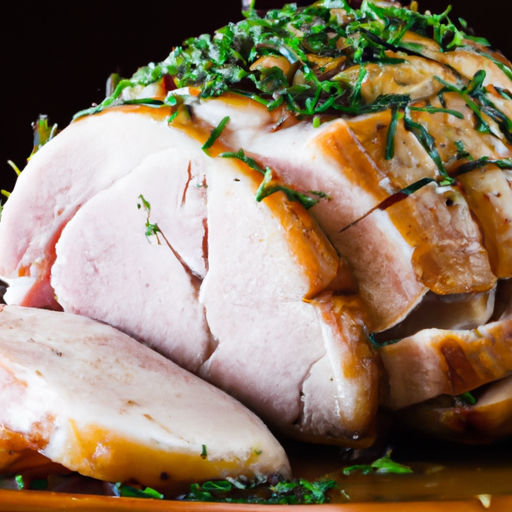The Delightful and Versatile Boneless Pork Roast
When it comes to succulent and tender cuts of meat, few can match the mouth-watering appeal of boneless pork roast. This versatile cut, extracted from the loin or shoulder of a pig, offers a delightful combination of flavor and tenderness that makes it a staple in kitchens worldwide. In this blog post, we will explore the taste, common uses in cooking, nutritional value, and interesting facts about boneless pork roast.
Taste Sensations Await
Boneless pork roast boasts a rich and robust taste that is sure to satisfy even the most discerning palates. The natural marbling of fat within the meat lends it a succulent and juicy quality, ensuring that each bite is an explosion of flavor. The inherent sweetness of pork, balanced perfectly with its umami undertones, creates a harmonious taste experience that pairs well with a wide range of ingredients and seasonings.
Culinary Versatility
The versatility of boneless pork roast opens up a world of culinary possibilities. Whether you opt for a traditional cooking method or experiment with modern culinary techniques, this cut of meat can elevate any dish to new heights. Here are a few popular cooking methods and dishes that showcase the adaptability of boneless pork roast:
Roasting: Slow-roasting boneless pork for hours sets the stage for that coveted tender and juicy texture. The aromatic spices and herbs infused during the cooking process create a symphony of flavors that make roasting a timeless classic.
Braising: Braising boneless pork roast in a savory liquid, such as broth or wine, results in a melt-in-your-mouth texture and an alluring depth of flavor. The slow cooking process allows the meat to absorb the surrounding flavors, turning an ordinary cut into a culinary masterpiece.
Barbecuing: Whether smoking or grilling, boneless pork roast is a favorite on any barbecue menu. The smoky flavors that permeate the meat, coupled with the caramelized exterior, create a tantalizing contrast that is simply irresistible.
Nutritional Bonuses
Not only does boneless pork roast invite an explosion of flavors, it also provides a host of essential nutrients. This delectable cut of meat is an excellent source of high-quality protein, which plays a vital role in repairing and building our bodies. Additionally, pork roast is packed with essential vitamins and minerals, including thiamin, niacin, vitamin B6, phosphorus, and selenium. It also offers a healthy dose of healthy fats, contributing to a well-rounded and nutritious diet.
Fun Facts and Historical Tidbits
Did you know that pork roast has been enjoyed by many cultures throughout history? In Ancient Rome, for example, it was a culinary delicacy and often prepared with exotic spices.
The celebrated dish, “Pulled Pork,” which is the result of slow-cooking boneless pork roast until it’s tender enough to be easily shredded, has its roots in Southern United States cuisine. It has since gained popularity worldwide and is often enjoyed in sandwiches or tacos.
If you’re planning a festive meal, boneless pork roast can be an excellent centerpiece. Its impressive presentation, coupled with its succulent taste, is sure to impress your guests.
So, whether you’re planning a cozy family dinner or a festive feast, boneless pork roast should be on your culinary radar. Its flavorful taste, culinary adaptability, and nutritional benefits make it an exceptional choice for any occasion. Embrace the versatility of this cut, let your creativity run wild, and prepare to delight your taste buds with a tantalizing boneless pork roast creation.
Boneless Pork Roast
Origin: Boneless pork roast is commonly made from the loin or shoulder of a pig. The domestication of pigs for meat consumption dates back thousands of years, with pork being one of the most widely consumed meats globally.
Common Uses: Boneless pork roast is a versatile cut of meat that can be used in a variety of dishes. It is often roasted or slow-cooked to create a tender and flavorful centerpiece for a meal. It can also be sliced and used in sandwiches, diced for stir-fries, or used as an ingredient in stews and casseroles.
Nutritional Benefits: Boneless pork roast offers several nutritional benefits. It is a good source of protein, essential for building and repairing tissues in the body. It also provides vitamins and minerals such as thiamin, niacin, vitamin B6, phosphorus, and zinc. However, it is important to note that pork roast can also contain fat, so it is recommended to select lean cuts or trim excess fat before cooking.
Unique Properties or Historical Significance: Pork has a long history of being consumed by various cultures throughout the world. In many culinary traditions, pork roast is considered a celebratory dish and is often featured during festive occasions and holidays. The fat content of pork roast can contribute to its tenderness and flavor, making it a popular choice for slow cooking methods such as roasting or braising. Additionally, the crispy crackling that can be achieved when cooking pork roast adds a unique texture and taste experience.




Use the share button below if you liked it.
It makes me smile, when I see it.